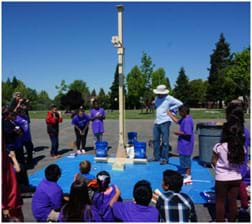Materials List:
Naked Egg Drop
 https://www.teachengineering.org/activities/view/ucd_eggdrop_activity1
https://www.teachengineering.org/activities/view/ucd_eggdrop_activity1
Each group needs:
- 1 or more sheet(s) of paper, to sketch and plan egg catcher designs
- pencils
- scissors
- tape and/or glue; white glue for younger students; hot glue for adult helpers and older students
- at least 1 raw egg (depending on the number of testing trials planned per group)
- computer with Internet access, for the research phase of the engineering design process
- Novice Engineer Pre-Assessment, one per student
- Naked Egg Drop Rules and Score Sheet, one per group
- Expert Engineer Post-Assessment, one per student
To share with the entire class: materials for building egg catchers:
- Provide materials such as cardboard or paperboard, clean food containers, foam, tissue paper, fabric, rubber bands, packing peanuts, fiberfill, bubble wrap, cotton balls, grass and other soft and cushiony materials. Reduce the cost by salvaging these materials as much as possible and/or asking students to salvage and bring items from home.
- Do not provide the following materials because they are such excellent shock absorbers (it is nearly impossible to break the egg from amazing heights): food and food ingredients, powders (sand, flour, baby powder), and pastes and gels that stay wet.
Competition supplies to share with the entire class:
- 6 foot (or taller) ladder
- tape measure
- tarp, newspaper or butcher paper, to simplify clean up
- concrete or asphalt slab on which to hold the egg drop competition since grass absorbs a significant amount of shock
- (optional alternative to the ladder) To improve student safety and increase the wow factor, build an egg dropper rig using the materials list and building instructions provided in the Egg Dropper Construction and Use (see Figure 2). Building the device is especially recommended if a district or regional competition is planned as part of the Elementary School Engineering Design Field Day unit, since its labor and material costs can be shared among many instructors/classrooms/schools. Estimated materials cost for the rig is ~$300.
- (optional) Especially helpful for large competition events, make a tool to enable quick measurements of egg catcher diameters and heights before the egg drop, as a way to easily enforce the design constraints. The homemade device in Figure 6 consists of a 25-cm diameter circle cut out of wood and an arm with a sliding ruler for measuring device height.
- (optional) For the testing/competition, it may be helpful to have a few other adults or older students on hand to serve as judges and helpers to perform material and dimension checks.

Figure 2. Students keep their eyes on the egg during the naked egg drop competition.
 https://www.teachengineering.org/activities/view/ucd_eggdrop_activity1
https://www.teachengineering.org/activities/view/ucd_eggdrop_activity1